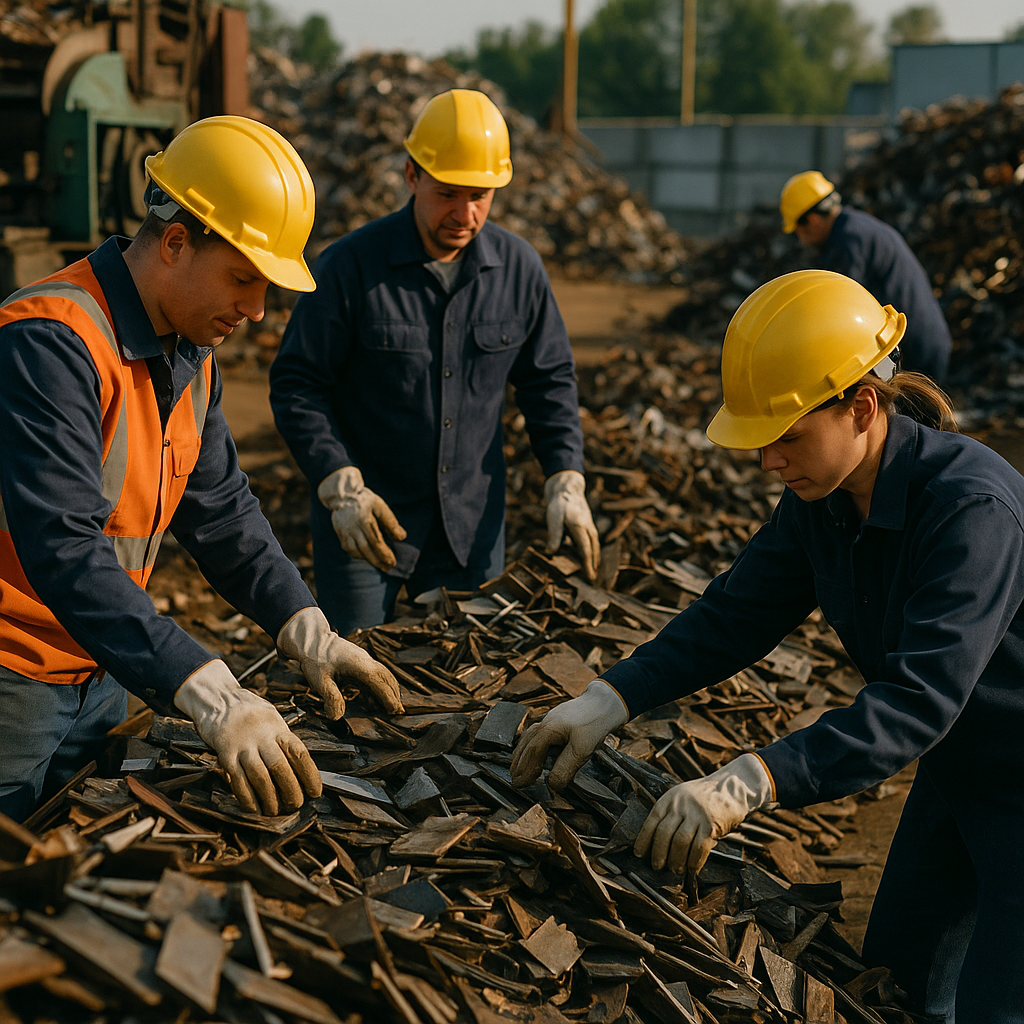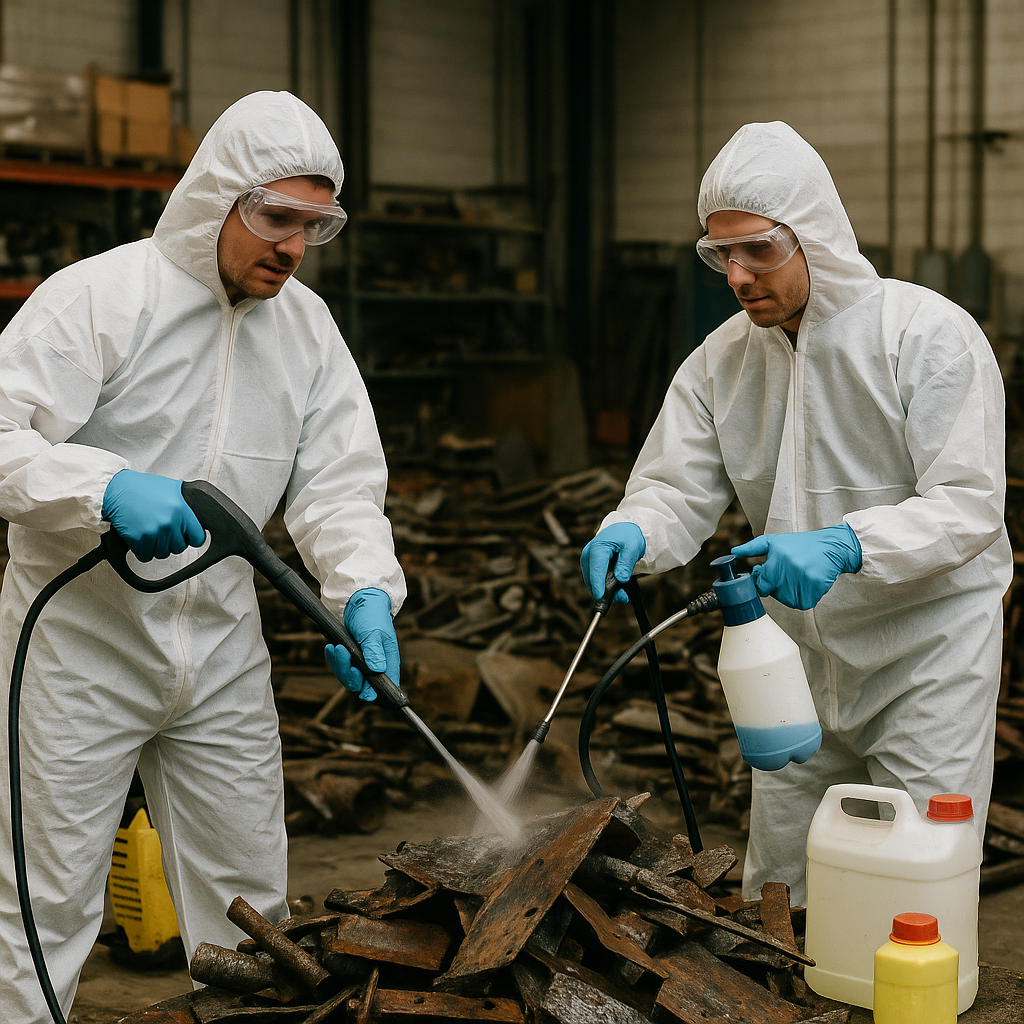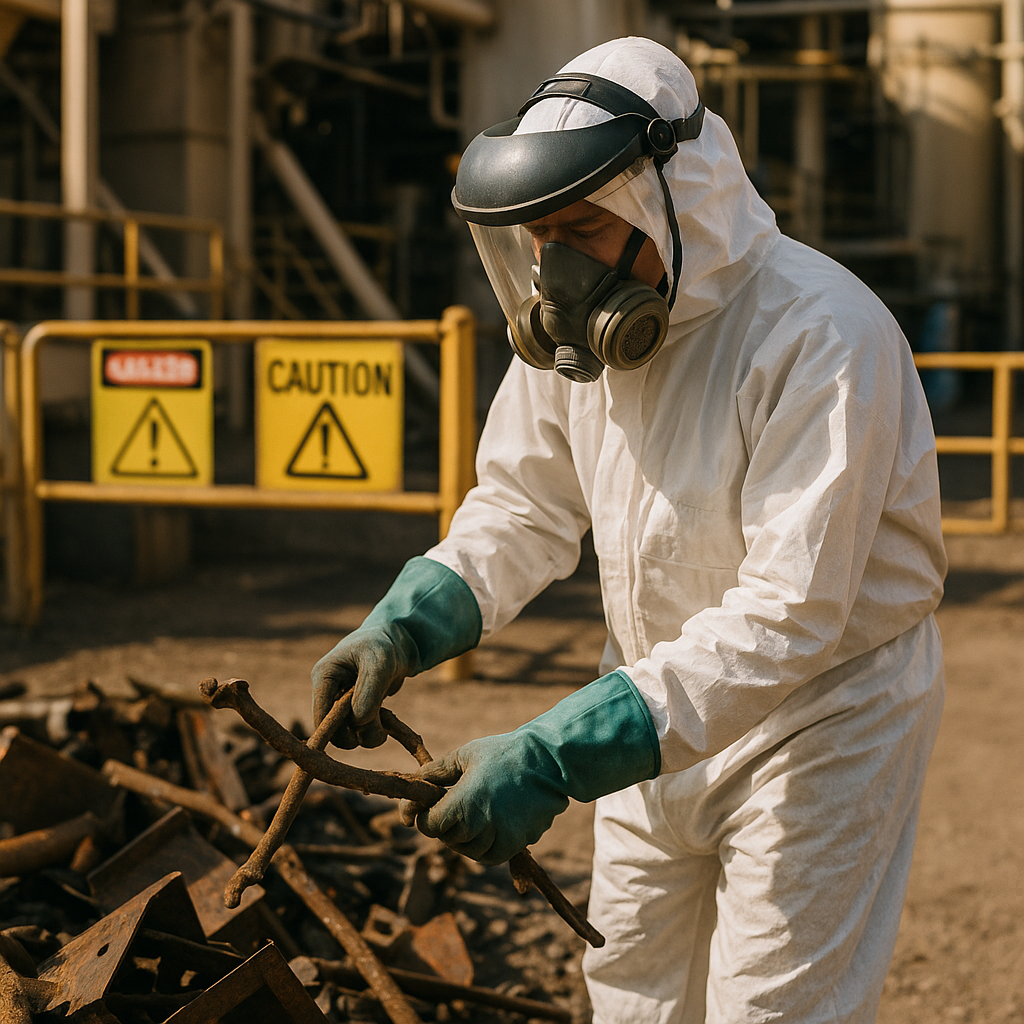5901 Botham Jean Blvd, Dallas, TX 75215
Scrap Metal Decontamination: Preparation Steps, Methods, Safety, and Value Impact
October 7, 2025Scrap metal decontamination involves removing contaminants and impurities from recycled metals, restoring their key properties and value. This essential step transforms scrap metal from waste into a valuable manufacturing resource by eliminating radioactive contamination, dirt, coatings, and other unwanted materials.
When metals are contaminated, they lose many desirable characteristics. Effective decontamination allows these materials to safely re-enter the manufacturing cycle. The process varies depending on the type and level of contamination.
For industrial recyclers, decontamination serves two crucial purposes. First, it reduces health and environmental risks by removing hazardous substances like radioactive materials, which could pose serious dangers if untreated. Second, it significantly increases the economic value of scrap metal, making it suitable for reuse in new products. This dual benefit establishes decontamination as a cornerstone of sustainable metal recycling practices.
What Are the Key Steps in Preparing Scrap Metal for Decontamination?

Proper preparation of scrap metal before decontamination is crucial for efficient processing and effective contaminant removal. The process involves methodical sorting, cleaning, and sizing to achieve optimal results. Let’s examine the essential preparation steps that enhance decontamination effectiveness.
Sorting Metals by Type
The first critical step involves identifying and separating different metal categories. This classification forms the foundation for all subsequent decontamination processes.
- Ferrous metals: These iron-containing materials, like steel, iron, and cast iron, respond to magnets. Simple magnet tests quickly identify these metals.
- Non-ferrous metals: Materials like aluminum, copper, brass, and stainless steel contain no iron. These typically have higher value but require different decontamination approaches.
Proper sorting prevents cross-contamination between different metal types, ensuring each category receives appropriate treatment. Mixing metal types can compromise the decontamination process and reduce the quality of the recovered materials.
Removing Non-Metal Attachments
Non-metal components must be detached before decontamination begins, increasing metal purity and preventing processing complications.
Common attachments requiring removal include plastic handles, rubber gaskets, wooden components, and electronic parts. These materials can interfere with decontamination chemicals or processes and potentially create hazardous byproducts when exposed to treatment solutions.
For complex items like appliances or machinery, disassembly should follow manufacturer guidelines where available to ensure safe removal of all non-metal parts.
Cleaning Off Surface Contaminants
Removing surface dirt, grease, paint, and debris is essential for decontamination agents to work directly on the metal surface. Cleaning methods vary based on the type and level of contamination.
- Mechanical cleaning: Wire brushing, sandblasting, or pressure washing removes surface dirt and loose contaminants.
- Chemical cleaning: Degreasers and solvents help remove oils, greases, and stubborn residues that mechanical methods cannot address.
- Rust removal: For ferrous metals, removing rust improves decontamination effectiveness and metal recovery rates.
Thorough cleaning ensures decontamination chemicals or processes can directly contact the metal surface without interference.
Cutting and Sizing
Large metal pieces must be reduced to manageable sizes that fit decontamination equipment and allow for uniform treatment.
Cutting techniques include using industrial shears, plasma cutters, or bandsaws depending on the metal type and thickness. The goal is to create uniform pieces that maximize surface area exposure to decontamination agents while maintaining safe handling.
Standard sizing also improves batch processing efficiency and allows for more precise calculation of decontamination chemical requirements.
Special Handling for Radioactive Scrap
Radioactive scrap metal requires additional precautions beyond standard preparation steps. Safety is the paramount concern when handling these materials.
- Radiation survey: Testing with specialized equipment determines contamination levels and identifies hotspots before handling.
- Containment protocols: Using sealed containers, specialized ventilation, and controlled environments prevents the spread of radioactive particles.
- Personnel protection: Workers must use appropriate personal protective equipment including respirators, coveralls, and dosimeters to monitor radiation exposure.
- Documentation: Maintaining detailed records of material source, contamination levels, and handling procedures is legally required for radioactive materials.
For technetium-99 and other radioactive contaminants, specialized membrane-based electrorefining processes may be necessary after initial preparation steps are complete.
Inspection and Documentation
Final inspection ensures all preparation steps have been properly completed before decontamination begins. This verification prevents processing delays and quality issues.
Documentation should record metal types, quantities, preparation methods used, and any special handling requirements. This information supports quality control throughout the decontamination process and provides traceability for regulatory compliance.
Photography or scanning may be used to create visual records of prepared materials, especially for radioactive or hazardous scrap requiring special monitoring.
Proper preparation is not merely a preliminary step but a critical determinant of decontamination success. By following these systematic procedures, recycling facilities can maximize material recovery rates while ensuring worker safety and environmental protection throughout the decontamination process.
What Decontamination Methods Are Used for Different Types of Scrap Metal?

Scrap metal decontamination requires specialized approaches based on the metal type and the contamination issue. The right method ensures contaminants are effectively removed while preserving the metal’s integrity for recycling or reuse. Each technique targets specific metals and contaminant types with varying levels of effectiveness.
Choosing the appropriate decontamination approach depends on several factors, including the metal’s composition, type of contamination, end-use requirements, and environmental considerations. Here are the most effective methods used for different metal types.
Electrolysis: Precise Removal for Conductive Metals
Electrolysis is effective for treating copper and aluminum by using an electrical current to separate contaminants from metal surfaces. This electrochemical process creates an electrical field that causes contaminants to migrate away from the metal being cleaned.
During electrolysis, the contaminated metal serves as an anode in an electrolytic cell. As current passes through an electrolyte solution, contaminants dissolve and either precipitate as sludge or remain in solution. The clean metal can then be recovered with significantly reduced contamination levels.
For copper components from industrial equipment, electrolysis using phosphoric acid as an electrolyte can achieve decontamination factors exceeding 100:1. Aluminum parts respond particularly well to electrolysis with sodium sulfate solutions, removing surface oxidation and embedded contaminants.
Chemical Treatments: Versatile Solutions for Various Metals
Chemical decontamination uses specific reagents to dissolve contamination layers without significantly damaging the base metal. This approach is highly effective for zinc, gold, and other precious metals where preserving material value is critical.
For zinc components, dilute acids like hydrochloric acid efficiently remove surface oxides and contaminants. Gold decontamination typically employs cyanide-based solutions that selectively dissolve contaminants while preserving the precious metal.
Chemical processes often involve multiple stages: first, an oxidizing solution breaks down contamination layers, followed by complexing agents that bind to dissolved contaminants for removal. For example, alkaline permanganate solutions followed by citric acid treatments effectively clean stainless steel components by first oxidizing chromium compounds and then complexing the dissolved metals.
Thermal Purification: Heat-Based Cleaning for Ferrous Metals
Thermal purification excels at treating iron, steel, and tin by using high temperatures to separate contaminants. This process involves heating metal until impurities either vaporize, form slags, or float to the surface for skimming.
For contaminated iron components, heating to 1400-1600°C in the presence of oxidizing fluxes causes impurities to form a slag layer that can be physically separated. Tin purification often employs lower temperatures (around 800-1000°C), where contaminants either oxidize or form compounds that float to the surface for removal.
This method is particularly effective for removing organic contaminants and some heavy metals from ferrous scrap. The process creates a cleaner metal product while concentrating contaminants in slag that can be properly managed as waste.
Plasma Processing: Advanced Technology for Specialty Metals
Plasma processing is a cutting-edge decontamination technology ideal for high-value specialty metals like titanium. It uses ionized gas (plasma) at extremely high temperatures to break chemical bonds between metals and contaminants.
During plasma processing, contaminated titanium is exposed to plasma at temperatures exceeding 5,000°C. This extreme heat breaks down even the most stubborn contamination without excessive damage to the base metal. The process can achieve remarkable decontamination factors while preserving the structural integrity of specialty alloys.
This technology excels at processing complex titanium components where conventional methods might cause damage or prove ineffective. Although more costly than other methods, plasma processing delivers exceptional results for high-value specialty metals where purity requirements are stringent.
Specialized Processes for Radioactive Decontamination
Radioactive scrap metal presents unique challenges requiring specialized decontamination approaches. Conventional methods are often ineffective against radioactive contamination, especially volumetric contamination that permeates throughout the metal.
Manufacturing Sciences Corporation (MSC) developed an innovative electrorefining process specifically designed to remove radioactive contaminants like Technetium-99 from nickel. Unlike traditional electrorefining, MSC’s process incorporates a permeable, ion-selective membrane between the anode and cathode that prevents Technetium-99 from reaching the cathode.
The process begins with dissolving contaminated nickel anodically in a sulfate-based electrolyte. Nickel ions migrate toward the cathode where purified nickel deposits, while the membrane blocks Technetium-99 contaminants. A filtration system continuously removes the radioactive material from the electrolyte. This specialized approach can reduce Technetium-99 contamination to levels below 1 Becquerel per gram, making previously unusable radioactive metal potentially recyclable.
Mechanical Methods: Physical Removal Techniques
Mechanical decontamination employs physical force to remove contaminants from metal surfaces. Techniques such as abrasive blasting, ultrasonic cleaning, and high-pressure water jetting are effective for surface contamination on various metals.
Abrasive blasting uses materials like steel grit, glass beads, or even CO2 pellets propelled at high speed to strip contamination from metal surfaces. This technique works exceptionally well on steel structural components with paint, rust, or surface contamination. When properly contained, these systems can achieve high decontamination factors while generating minimal secondary waste.
Ultrasonic cleaning is excellent for removing contamination from complex geometries and small parts by using high-frequency sound waves to create microscopic cavitation bubbles in a cleaning solution. When these bubbles collapse, they generate intense localized pressure that dislodges contaminants from even the most intricate surfaces.
Each decontamination method comes with specific advantages and limitations. The selection process must balance effectiveness, cost, waste generation, and environmental impact. For complex decontamination challenges, combinations of methods often yield the best results, such as using mechanical techniques to remove bulk contamination followed by chemical or electrochemical processes for final cleaning.
As environmental regulations become more stringent and resource conservation grows more important, efficient metal decontamination technologies play a crucial role in enabling the recycling and reuse of valuable materials that might otherwise require disposal. Advanced research continues to improve these techniques, making them more effective, economical, and environmentally sustainable.
What Safety Precautions Are Necessary When Decontaminating Scrap Metal?

Safety precautions are essential when decontaminating scrap metal, particularly when handling radioactively contaminated materials. The decontamination process presents multiple hazards that require careful management to protect workers, the public, and the environment.
Personal Protective Equipment (PPE)
Proper PPE forms the first line of defense against contamination exposure. Workers should wear:
- Multiple layers of disposable gloves to prevent direct contact with contaminated surfaces
- Protective coveralls or lab coats that fully cover the body
- Safety glasses or splash goggles to protect eyes from chemical splashes and particles
- Respiratory protection appropriate for the contaminants present
- Disposable shoe covers to prevent tracking contamination
Regular monitoring of gloved hands and shoe covers is crucial during the decontamination process. When contamination is detected, PPE should be changed immediately to prevent cross-contamination.
Controlled Work Environments
Creating a controlled environment is vital for containing contamination. Key controls include:
- Dedicated decontamination areas with appropriate ventilation systems
- Negative pressure containment when working with radioactive materials
- Clear demarcation of contaminated zones
- Proper drainage systems to collect and treat contaminated liquids
- Monitoring systems to detect radiation levels at work zone perimeters
For radioactive scrap metal decontamination, portal monitors at entry and exit points help detect radioactive materials and prevent inadvertent spread of contamination beyond the controlled area.
Decontamination Procedures
Following proper decontamination procedures is critical for safety. Essential steps include:
- Notifying all personnel in the area about the decontamination activity
- Covering spills with absorbent materials to contain contamination
- Working from areas of lower contamination to higher contamination
- Cleaning surfaces from the perimeter toward the center to avoid spreading contamination
- Using appropriate cleaning methods based on contamination type
- Performing regular radiation surveys during and after decontamination
After decontamination, conduct comprehensive surveys of the area, equipment, and personnel to ensure no contamination has spread.
Specialized Precautions for Radioactive Decontamination
Radioactive scrap metal requires additional precautions:
- Radiation monitoring equipment to measure contamination levels before, during, and after the process
- Time, distance, and shielding principles to limit radiation exposure
- Specialized containment systems for volatile radioactive materials
- Proper waste management for radioactive residues
- Decontamination verification through wipe tests and radiation surveys
If radioactive contamination is detected on skin, wash the affected area with lukewarm water and mild soap. Avoid aggressive scrubbing that could create skin abrasions and allow contamination to enter the body.
Training Requirements
Operator training is essential for safe decontamination processes. Training should cover:
- Recognition of contamination hazards
- Proper use of monitoring equipment
- Decontamination techniques
- Emergency response procedures
- Waste handling protocols
- Regulatory requirements
Only properly trained personnel should perform scrap metal decontamination. Regular refresher training helps ensure safety protocols remain current.
Regulatory Compliance
Adherence to regulatory guidelines is mandatory. Key compliance areas include:
- Following state radiation control program requirements
- Maintaining proper documentation of radiation surveys
- Ensuring proper disposal of contaminated waste
- Reporting incidents to appropriate authorities
- Implementing corrective actions for contamination events
Regulatory bodies like the Nuclear Regulatory Commission (NRC) and state agencies provide specific guidelines for handling radioactive materials that must be followed.
Emergency Response Planning
Effective emergency procedures must be in place before starting decontamination work. Critical elements include:
- Clear protocols for different emergency scenarios
- Decontamination procedures for personnel exposure
- Evacuation routes and assembly points
- Emergency contact information
- Spill containment materials and procedures
Regular drills help ensure workers can respond quickly and appropriately to emergencies.
| Personal Protective Equipment (PPE) | Disposable gloves, coveralls, safety glasses, respiratory protection, shoe covers |
| Controlled Work Environments | Dedicated decontamination areas, negative pressure containment, proper drainage systems |
| Decontamination Procedures | Notify personnel, contain spills, work from low to high contamination areas, conduct radiation surveys |
| Specialized Precautions for Radioactive Decontamination | Radiation monitoring, time-distance-shielding principles, waste management, wipe tests |
| Training Requirements | Contamination hazard recognition, equipment use, emergency response, waste handling |
| Regulatory Compliance | State radiation control programs, disposal documentation, incident reporting |
| Emergency Response Planning | Protocols for emergencies, personnel decontamination, evacuation routes |
The significant risks associated with decontaminating radioactive scrap metal cannot be overstated. Cleanup of sites where radioactive material has been improperly managed can cost millions of dollars. More importantly, radioactive sources or contaminated scrap can significantly harm workers at metal processing facilities. By implementing comprehensive safety measures, these risks can be minimized while still achieving effective decontamination.
Conclusion: The Future of Scrap Metal Decontamination
The economic and environmental benefits of effective scrap metal decontamination are substantial. By improving recovery efficiency and material purity, these processes reduce the need for resource-intensive mining operations. This, in turn, conserves natural resources, decreases greenhouse gas emissions, and prevents hazardous materials from reaching landfills.
As the circular economy expands, decontamination technologies will play an even more crucial role in meeting the growing demand for high-quality recycled materials across the manufacturing, construction, and renewable energy sectors. For recycling and decontamination services, contact Okon Recycling at 214-717-4083.
